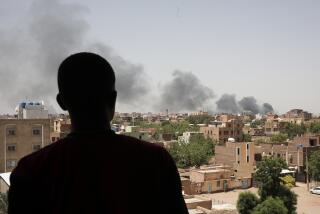Somalia: Terrorists’ Next Stop?
- Share via
As President Bush and his national security team have constantly reminded us, the U.S. is not at war with individual nations but with terrorists and the governments that support them. This is why we attacked the Taliban in Afghanistan and why we will probably use military force in Somalia.
In fact, small numbers of U.S. special operations forces have visited Somalia, and U.S. patrol planes and British and French aircraft are flying reconnaissance missions over the area looking for terrorists’ camps and other indications of terrorist activity.
For Americans, the thought of sending U.S. military people into Somalia no doubt will conjure up horrible images of Mogadishu on Oct. 3, 1993. On that day, 18 U.S. Rangers were killed, 75 more were wounded and dead Americans were dragged through the streets during an unsuccessful attempt to capture Somalian warlord Gen. Mohammed Farah Aidid. Public reaction to this event forced President Clinton to pull out U.S. forces, and the subsequent withdrawal of the U.N. allowed Somalia to fall back into the chaos that led the elder George Bush to send American troops there in the first place.
Aidid himself was killed by a rival faction in the summer of 1996. Even today, there is no true national government. The so-called transitional national government controls only part of Mogadishu--the capital--with the remainder of the country divided up among dozens of warlords.
This chaotic atmosphere has been fertile ground for Al Qaeda and other terrorist groups. In fact, there is evidence that Osama bin Laden supported groups that aided Aidid in 1993, and that Somalia was the launching pad for the bombings of the U.S. embassies in Kenya and Tanzania in 1998. Al Qaeda claimed credit for the Oct. 3, 1993, killings of the U.S. Rangers.
And, with Al Qaeda on the run from Afghanistan and countries like Yemen, Egypt and Sudan cracking down on terrorists, Somalia would be a likely refuge for members of the Al Qaeda network.
If the U.S. is to be as successful in Somalia as it has been in Afghanistan, it must keep in mind several lessons from that experience.
First, some local warlords will attempt to use U.S. intervention to further their own interests rather than crack down on terrorists. Many of these warlords have accused the transitional government of supporting terrorism and have urged the U.S. to destroy that government.
Second, the U.S. also must be wary of helping the states that surround Somalia that are inclined to use our interest for their own purposes. Ethiopia, the strongest U.S. ally in the region and a strong supporter of U.S. involvement, has a historical fear of a strong Somalia and actively supports and controls the warlords in the south of Somalia. In December, Ethiopia refused to allow its warlords to attend a Somalia-sponsored conference designed to broker a power-sharing arrangement for the country.
Third, if the U.S. does intervene militarily in Somalia, it cannot leave quickly. A quick military attack followed by a hasty withdrawal would make things worse and create a fertile environment for future terrorists. The humanitarian situation there is already dire. Some 300,000 Somalis in the southern part of the country face starvation because of a drought.
Moreover, because of U.S. suspicions that it has helped finance Al Qaeda, the assets of Al Barakaat, the country’s largest bank, have been frozen.
Finally, U.S. military intervention must be quite modest, and done in cooperation with other nations, particularly African countries. The so-called Islamic Unity terrorist group, which has been supported by Bin Laden, is not very formidable. It has only 2,000 hard-core supporters and is equipped with only small arms. They have been joined by less than 100 Al Qaeda terrorists fleeing Afghanistan. Moreover, to the extent that it can work with local tribes and warlords, the U.S. not only limits the risks to its own troops but also avoids evoking memories of the 1992-93 intervention of some 30,000 U.S. troops.
If the U.S. keeps these points in mind, it will be able to continue to make progress in the war against terrorism, and it will finish the work it left undone eight years ago, i.e., creating a stable government that can deal with Somalia’s humanitarian problems and prevent it from becoming a breeding ground for future acts of terrorism.
More to Read
Sign up for Essential California
The most important California stories and recommendations in your inbox every morning.
You may occasionally receive promotional content from the Los Angeles Times.













